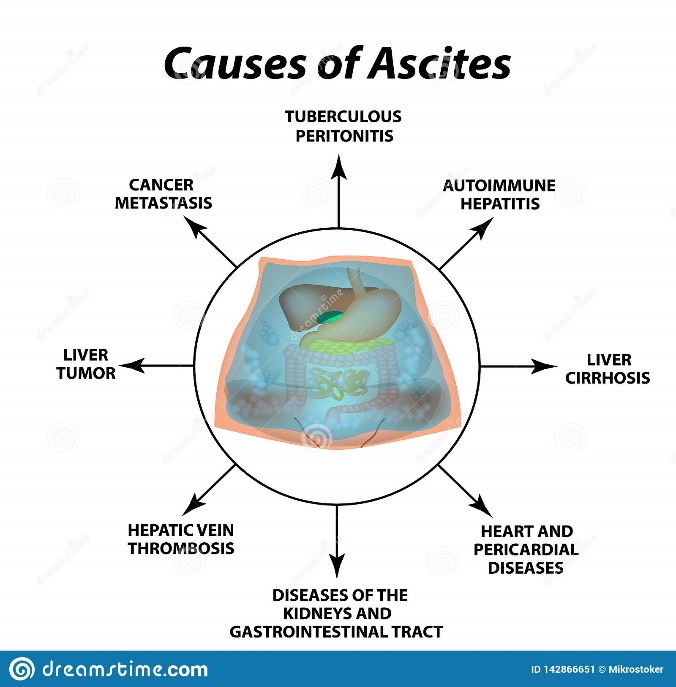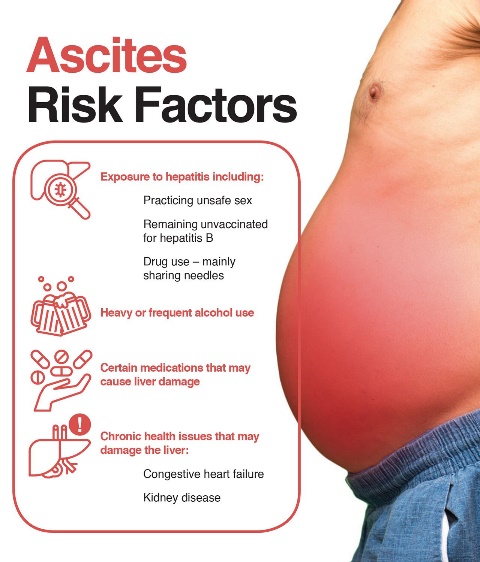Ascites
Ascites is the build-up of fluid in the stomach, as a result of severe liver disease. The extra fluid makes the abdomen swell up. This extra build-up usually occurs between the two membrane layers that together make up the peritoneum, a smooth sac that houses the body’s organs. It is, however, usual to have a […] Read More
Top Doctors For Ascites Treatments
Top Hospitals For Ascites Treatments
Ascites
What is ascites?
Ascites is the build-up of fluid in the stomach due to severe liver disease. The extra fluid makes the abdomen swell up. This extra build-up usually occurs between the two membrane layers that together make up the peritoneum, a smooth sac that houses the body’s organs. It is, however, usual to have a small amount of fluid in the peritoneum cavity. It is discomforting and cause nausea, tiredness, breathlessness, and a feeling of being full. Liver disease is the commonest cause of ascites. Other possible causes are cancer and heart failure.

Causes

The primary cause of ascites is liver scarring, known as cirrhosis. Scarring raises the pressure inside the liver’s blood vessels, which may force fluid into the abdominal cavity. Thereby resulting in ascites. Other causes due to liver problems may be:
- Viral hepatitis (B or C).
- Acute liver failure.
- Budd-Chiari syndrome: caused by blockage of the hepatic veins.
- Cancer that has metastasized or spread to the liver can also be the source.
Other primary causes are
- Heart failure.
- Cancer: Ascites is likely to develop if cancer affects the peritoneum, lymphatic system, ovaries, breast, bowel, stomach, pancreas, lung, and womb (uterus).
Underlying diseases responsible for ascites are
- Tuberculosis.
- Kidney disease.
- Pancreatitis.
- Nephrotic syndrome.
Symptoms
Ascites symptoms do not always hint at an emergency, but it is advisable to see a doctor if one experiences any of the following:
- A distended or swollen abdomen.
- Sudden weight gain.
- Difficulty in breathing when lying down.
- Diminished appetite.
- Abdominal pain.
- Bloating.
- Nausea and vomiting.
- Heartburn.
- Tiredness.
- Urinary urgency and constipation.
- Swelling in legs and ankles.
- Fever.
- Hernia.
- Indigestion.
How is ascites diagnosed?
Ascites diagnosis is of multiple approaches.
- Physical examination of the abdomen for swelling.
- Blood tests: To assess the function of the liver and the kidney.
- Fluid sample analysis: To ascertain diseases, like cancer or infection.
- Imaging Test: To see inside the abdomen. These include ultrasound, MRI, and CT scan.
- X–ray scan of the abdomen
- SAAG test– Serum Ascites Albumin Gradient is considered to be the single best test for classifying the condition into portal hypertensive (SAAG >1.1gm/dl) and non-portal hypertensive (SAAG <1.1gm/dl) causes.
- Cultural/gram stain– Is used to detect bacterial growth in the ascitic fluid.
- Cytology- They are sensitive to the detection of malignant ascites.
- Laparoscopy.
- Angiography.
How is ascites treated?
Treatment depends on the underlying cause.
- Diuretics: This is one of the most commonly used means for ascites treatment and is effective for most people with the condition. These drugs increase the quantity of salt and water leaving the body, thereby reducing the pressure within the veins around the liver. Furosemide (Lasix) and spironolactone (Aldactone) are the most commonly used diuretics.
- Paracentesis: A long thin needle is used to remove the extra fluid for this procedure. This treatment option is often used when the ascites is severe or recurrent.
- Diet: Restricting salt (sodium) and increasing the body’s water is a large part of treating this condition.
- TIPS: Transjugular intrahepatic portosystemic shunt. This procedure is performed to treat fluid build-up in the abdomen.
- Surgery: In life-threatening cases, a permanent tube known as a shunt is implanted in the body. It redirects blood flow around the liver. A liver transplant may also be recommended if ascites does not respond to treatment. This is used mainly for end-stage liver disease.
- Chemotherapy: This may help to shrink or control cancer. It is administered through a tube in the abdomen. This can sometimes stop fluid build-up.
FAQ
The single biggest risk factor is liver damage. This may be due to cirrhosis, hepatitis B or C, or a history of alcohol abuse.
Other possible risk factors include:
a) Ovarian, pancreatic, liver, or endometrial cancer.
b) Heart or kidney failure.
c) Pancreatitis.
d) Tuberculosis.
e) Hypothyroidism.
f) Cancer in organs in the abdominal area.
g) Kidney failure.
h) Congestive heart failure.
Picture Courtesy: aminoco
Complications associated with it may include:
a) Abdominal pain.
b) Pleural effusion (water on the lung). This can lead to difficulty in breathing.
c) Hernias; like inguinal hernias.
d) Bacterial infections.
e) Hepatorenal syndrome; is a rare kind of progressive kidney failure.
f) Difficulty in eating, drinking, and moving around.
g) Hepatic hydrothorax or fluid in the lungs.
The prognosis and long-term outlook depend on the underlying condition. While symptoms can be managed and reduced, treating the underlying cause determines the outcome.
Presently, there is no satisfactory treatment for people who have cirrhosis.
Paracentesis and shunts not accompanied by a liver transplant may improve a person’s quality of life but are not seen to improve long-term life expectancy significantly.
The development of ascites can’t, unfortunately, be prevented. However, its risks can be reduced by protecting the liver.
The patient can try adopting these healthy habits:
a) Quit alcohol consumption: This can go a long way to help prevent cirrhosis.
b) Hepatitis B vaccination.
c) Avoid sharing needles, as Hepatitis can be transmitted through shared needles.
Know the potential side effects of the medications the patient consumes.
Ascites is a sign of liver damage. Over some time, if left untreated, it can cause life-threatening complications. Early diagnoses and treatment of ascites will have a better outcome.
Ascites (fluid collection in the abdominal cavity) rarely occur in a normal healthy person. Instead, it is seen as most common in liver cirrhosis patients. About half of the people diagnosed with decompensated liver cirrhosis will develop ascites. Cirrhosis accounts for about 80% of cases of ascites.
The fluid in the abdominal cavity can continue to build up. Therefore, the patient may be required to drain the fluid through the ascites tapping procedure. If the fluid builds up quickly, the doctor might suggest the patient undergo medical or surgical intervention like diuretics medications, TIPS procedures, or liver transplantation based on the patient’s condition.
Ascites can’t be resolved on its own. The person has to make some changes in their diet and lifestyle; in a few cases, they might have to take a few medications to treat it.
Edema is simply a medical terminology for swelling or puffiness in different body parts, usually under the skin. While ascites means the presence of flu



























































































